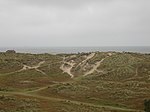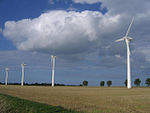Winterton-Horsey Dunes

Winterton-Horsey Dunes is a 427-hectare (1,060-acre) biological and geological Site of Special Scientific Interest north of Great Yarmouth in Norfolk. It is a Special Area of Conservation and a Nature Conservation Review site, Grade I. Winterton Dunes is a National Nature Reserve Winterton Ness is a Geological Conservation Review site. The whole site is in the Norfolk Coast Area of Outstanding Natural Beauty. This site has extensive dunes together with areas of grazing marsh and birch woodland. Invertebrates include a rare amphibian and a rare butterfly. The site is geologically important as it displays the processes which control dynamic dune development.The beach is open to the public.
Excerpt from the Wikipedia article Winterton-Horsey Dunes (License: CC BY-SA 3.0, Authors, Images).Winterton-Horsey Dunes
Somerton Holmes Gap,
Geographical coordinates (GPS) Address Nearby Places Show on map
Geographical coordinates (GPS)
| Latitude | Longitude |
|---|---|
| N 52.733 ° | E 1.678 ° |
Address
Somerton Holmes Gap
Somerton Holmes Gap
NR29 4DY , Winterton-on-Sea
England, United Kingdom
Open on Google Maps









